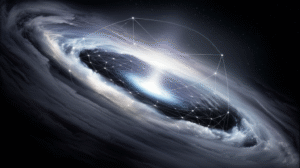The Cosmic Puzzle: Dark Matter and Dark Energy
Explore the mysteries of dark matter and dark energy — invisible forces shaping the universe’s structure, expansion, and ultimate fate.
Introduction to the Universe’s Hidden Forces-Dark Matter & Dark Energy.
The Mystery That Baffles Scientists
Dark matter and dark energy dominate the universe’s mass-energy content. Yet, scientists understand little about them. These hidden forces shape the cosmos’s structure and expansion. Despite their invisibility, their effects are observable. For instance, galaxies rotate faster than visible matter can explain. This discrepancy hints at dark matter’s presence. Similarly, the universe’s accelerated expansion suggests dark energy’s influence. Researchers strive to uncover these mysteries through advanced telescopes and particle detectors.
A Glimpse Into the Unknown
Exploring dark matter and dark energy challenges our understanding of physics. Traditional models fail to explain their properties fully. Innovations in technology and theory offer hope. Experiments like the Large Hadron Collider may detect dark matter particles. Space telescopes, such as the James Webb, could reveal dark energy’s secrets. Each discovery brings us closer to solving these cosmic puzzles. The journey to understand these forces continues to inspire scientists worldwide.
Dark Matter – The Invisible Architect
What Lies Beyond Our Sight?
The Discovery That Changed Astronomy Fritz Zwicky
Fritz Zwicky first proposed dark matter in 1933. He noticed galaxies in the Coma Cluster moved too fast. Their visible mass couldn’t explain this motion.
Why Can’t We See Dark Matter?
Dark matter doesn’t emit, absorb, or reflect light. It interacts gravitationally, making its presence known through its effects on visible matter.
The Evidence That Speaks Volumes
Galactic Rotation Curves: The First Clue
Stars orbit galaxies at speeds that shouldn’t be possible. Dark matter’s gravitational pull explains these unexpected velocities.
Gravitational Lensing: Nature’s Magnifying Glass
Light bends around massive objects. Dark matter’s gravity distorts light from distant galaxies, revealing its distribution.
Cosmic Microwave Background: Echoes of the Big Bang
Tiny temperature fluctuations in the CMB suggest dark matter’s role in the universe’s structure formation.
Galaxy Clusters: The Weight of the Invisible
Galaxy clusters contain more mass than their visible components. Dark matter accounts for this discrepancy.
The Quest to Identify Dark Matter
WIMPs: The Leading Candidates
Weakly Interacting Massive Particles (WIMPs) are theoretical particles. They could explain dark matter’s gravitational effects without emitting light.
Axions: The Dark Horse
Axions are lightweight particles. They might solve dark matter mysteries and issues in particle physics.
Sterile Neutrinos: A Neutrino’s Mysterious Cousin
Sterile neutrinos interact even less than regular neutrinos. They could be a component of dark matter.
MACHOs: The Theory That Almost Was
Massive Compact Halo Objects (MACHOs) like black holes were once candidates. Observations have largely ruled them out.
Why Dark Matter Matters
Building Blocks of the Universe
Dark matter’s gravity shaped the cosmos. It pulled matter together, forming galaxies and clusters.
The Cosmic Web’s Silent Builder
The cosmic web’s vast structure owes its existence to dark matter. It acts as the scaffolding for visible matter.
The Future of Dark Matter Research
Cutting-Edge Experiments on the Frontier
Scientists are hunting dark matter with underground detectors and particle colliders. These experiments aim to catch dark matter particles.
Next-Generation Observatories: Peering Deeper Into the Dark
Future telescopes will map dark matter’s distribution more precisely. They’ll test theories about its nature and role in the universe.
Chapter 2: Dark Energy – The Universe’s Mysterious Force
The Accelerating Universe
A Discovery That Won the Nobel Prize
In 1998, astronomers found the universe’s expansion is accelerating. This groundbreaking discovery earned the Nobel Prize in Physics in 2011. Dark energy, responsible for this acceleration, remains one of cosmology’s biggest mysteries.
How Dark Energy Defies Gravity
Unlike gravity, which pulls matter together, dark energy pushes the universe apart. Its repulsive force overcomes gravity’s attractive pull, leading to the observed acceleration.
Measuring the Immeasurable
Supernovae: Cosmic Yardsticks
Type Ia supernovae serve as standard candles. By measuring their brightness, scientists gauge distances across the cosmos. These measurements first hinted at the universe’s accelerated expansion.
Baryon Acoustic Oscillations: The Universe’s Fossil Record
Baryon acoustic oscillations (BAOs) are patterns in galaxy distribution. They act as a cosmic ruler, helping scientists measure the universe’s expansion rate over time.
The Integrated Sachs-Wolfe Effect: A Subtle Clue
This effect shows how dark energy changes the cosmic microwave background’s temperature. It provides indirect evidence of dark energy’s influence on the universe’s structure.
Theories Behind the Force
The Cosmological Constant: Einstein’s ‘Greatest Blunder’ Revisited
Einstein introduced the cosmological constant to balance the universe. Later, he called it his biggest mistake. Now, it’s a leading explanation for dark energy.
Quintessence: A Dynamic Dark Energy
Quintessence theory suggests dark energy’s strength varies over time. Unlike the cosmological constant, it’s a dynamic field that could change the universe’s fate.
Phantom Energy: A Doomsday Scenario?
Phantom energy could increase the universe’s expansion rate indefinitely. This scenario might lead to a ‘Big Rip,’ tearing apart galaxies, stars, and even atoms.
The Role of Dark Energy in Cosmic Destiny
The Fate of the Universe: Big Freeze, Rip, or Crunch?
Dark energy’s nature determines the universe’s end. A ‘Big Freeze’ sees expansion cooling everything. A ‘Big Rip’ destroys all structures. A ‘Big Crunch’ reverses expansion into a collapse.
The Cosmic Tug-of-War
Dark matter and dark energy dominate the universe’s mass-energy content. They influence cosmic structure and expansion. Dark matter’s gravity pulls galaxies together. Meanwhile, dark energy pushes the universe apart. This dynamic creates a cosmic tug-of-war.
How Dark Matter and Dark Energy Shape the Universe
Dark matter forms the universe’s scaffolding. It dictates galaxy formation and clustering. Dark energy, however, accelerates the universe’s expansion. Together, they determine the universe’s fate. Their balance affects everything from galaxy clusters to cosmic voids.
Unanswered Questions and Future Directions
Scientists still don’t understand dark matter’s nature. They also question why dark energy’s strength varies. These mysteries challenge current physics theories. Solving them could revolutionize our cosmic understanding.
The Next Great Discoveries in Cosmology
Researchers aim to map dark matter distribution more accurately. They also seek to measure dark energy’s effects over time. These efforts could reveal new physics. They might also explain the universe’s ultimate fate.
How New Technologies Could Unveil the Universe’s Secrets
Advanced telescopes and detectors are coming online. They will observe the cosmos in unprecedented detail. Quantum computing may simulate cosmic evolution. These tools could finally decode dark matter and dark energy.
Conclusion: The Ongoing Quest for Understanding
The search for dark matter and dark energy continues because they make up most of the universe. Yet, we know little about them. Scientists believe understanding these mysteries could change physics forever.
Why the Search for Dark Matter and Dark Energy Continues
Dark matter and dark energy dominate the cosmos. They influence galaxies and the universe’s expansion. Despite their prevalence, their nature remains elusive. This mystery drives ongoing research.
The Potential to Revolutionize Our Understanding of Physics
Discovering the true nature of dark matter and dark energy could unlock new physics. It might explain the universe’s acceleration and the missing mass in galaxies. Such breakthroughs would redefine our cosmic knowledge.









Dark matter and dark energy remain one of the greatest enigmas in modern science. Despite their invisible nature, their gravitational effects are undeniable, shaping the very fabric of the universe. The discovery of dark matter traces back to Fritz Zwicky, who observed anomalies in galaxy movements. Advanced technology continues to push the boundaries of our understanding. Will we ever be able to directly detect these elusive components of the cosmos?
The exploration of dark matter and dark energy reveals the profound mysteries of our universe. Despite being invisible, their influence on cosmic structures is undeniable and fascinating. Scientists use advanced tools like telescopes and particle detectors to decipher these enigmatic forces. The discovery of particles like WIMPs or axions could revolutionize our understanding of the cosmos. How do these hidden elements continue to shape the universe’s evolution?
es its existence to dark matter’s gravitational scaffolding. Without it, galaxies wouldn’t have formed as we see them today. Dark energy, meanwhile, drives the universe’s expansion to accelerate against gravity’s pull. Humanity stands at the frontier of cosmic understanding, grappling with mysteries that dwarf our planet. When will experiments finally reveal dark matter’s true nature?
1. **If dark matter doesn’t emit, absorb, or reflect light, how do scientists detect its presence?**
Scientists detect dark matter through its gravitational effects on visible matter, such as the faster rotation of galaxies or the bending of light around massive objects.
2. **What was Fritz Zwicky’s contribution to the study of dark matter?**
Fritz Zwicky first proposed the existence of dark matter in 1933 when he observed that galaxies in the Coma Cluster were moving too fast to be explained by their visible mass alone.
3. **What are WIMPs, and how might they explain dark matter?**
WIMPs (Weakly Interacting Massive Particles) are theoretical particles that could explain dark matter’s gravitational effects without emitting light, making them invisible yet detectable through their interactions.
4. **Why has the hypothesis of MACHOs (like black holes) as candidates for dark matter been largely ruled out?**
Observations have largely ruled out MACHOs (Massive Compact Halo Objects) like black holes as they don’t account for the discrepancy in mass that dark matter explains.
5. **How does dark matter influence the structure of the universe?**
Dark matter’s gravity pulled matter together, forming galaxies and clusters, thus shaping the structure of the cosmos.
—
**My opinion and questions:**
The study of dark matter and dark energy is fascinating because it reveals how much we still don’t understand about the universe. I wonder if there are any other theories or particles besides WIMPs, axions, and sterile neutrinos that could explain dark matter? Additionally, could you clarify more about how the Cosmic Microwave Background (CMB) suggests dark matter’s role in universe formation?
—
**Clarification:**
What does it mean for the cosmic web’s vast structure? Can you expand on this? Also, do scientists think dark energy could be related to dark matter, or are they entirely separate phenomena?
The concept of dark matter and dark energy is both fascinating and perplexing. It’s incredible how these invisible forces shape the universe, yet we know so little about them. The idea that galaxies rotate faster than visible matter can explain is mind-blowing. I wonder if there’s a possibility that dark matter could interact with other forces we haven’t discovered yet. The fact that dark energy is driving the universe’s accelerated expansion raises so many questions about the future of the cosmos. Do you think we’ll ever fully understand these mysteries, or will they remain elusive? It’s exciting to think about how advanced telescopes and particle detectors might bring us closer to the truth. What’s your take on the role of WIMPs or axions in solving the dark matter puzzle?
The concept of dark matter and dark energy is fascinating, yet it feels like we’re only scratching the surface of understanding. It’s incredible how something invisible can have such a profound impact on the universe’s structure and expansion. The idea that galaxies rotate faster than visible matter can explain is mind-blowing—what else are we missing? I wonder if dark matter could be connected to other unexplained phenomena in physics. The fact that researchers are using advanced telescopes and particle detectors gives me hope that we’ll uncover more soon. Do you think dark matter could ever be directly observed, or will it always remain an indirect mystery? What’s your take on the possibility of WIMPs or axions being the key to solving this puzzle?
The website design looks great—clean, user-friendly, and visually appealing! It definitely has the potential to attract more visitors. Maybe adding even more engaging content (like interactive posts, videos, or expert insights) could take it to the next level. Keep up the good work!